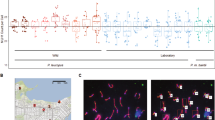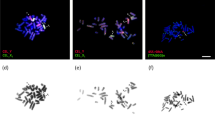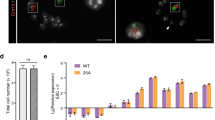Abstract
We report the unprecedented finding of a gene with a different map position in two mouse strains. The Clcn4 gene was found to map to the X chromosome in the wild Mediterrean mouse, Mus spretus but to chromosome 7 in the inbred strain of laboratory mouse C57BL/6J. These data indicate that a recent evolutionary rearrangement occurred on the mouse sex chromosomes, very close to the pseudoautosomal region. Our data provide molecular evidence for a major divergence near the pseudoautosomal region, consistent with the hypothesis that hybrid sterility in these species results from abnormal pairing of sex chromosomes during male meiosis.
This is a preview of subscription content, access via your institution
Access options
Subscribe to this journal
Receive 12 print issues and online access
$209.00 per year
only $17.42 per issue
Buy this article
- Purchase on Springer Link
- Instant access to full article PDF
Prices may be subject to local taxes which are calculated during checkout
Similar content being viewed by others
References
Rappold, G.A. The pseudoautosomal regions of the human sex chromosomes. Hum. Genet 92, 315–324 (1993).
Mohandas, T.K. et al. Role of the pseudoautosomal region in sex-chromosome pairing during male meiosis: meiotic studies in a man with a deletion of distal Xp. Am. J. hum. Genet. 51, 526–533 (1992).
Rouyer, F. et al. A gradient of sex linkage in the pseudoautosomal region of the human sex chromosomes. Nature 319, 291–295 (1986).
Soriano, P. et al. High rate of recombination and double crossovers in the mouse pseudoautosomal region during male meiosis. Proc. natn. Acad. Sci. U.S.A. 84, 7218–7220 (1987).
Haldane, J.B.S. Sex ratio and unisexual sterility in hybrid animals. J. Genet. 12, 101–109 (1922).
Coyne, J.A. The genetic basis of Haldane's rule. Nature 314, 736–738 (1985).
Matsuda, Y., Hirobe, T. & Chapman, V.M. Genetic basis of X-Y chromosome dissociation and male sterility in interspecific hybrids. Proc. natn. Acad. Sci. U.S.A. 88, 4850–4854 (1991).
Matsuda, Y., Moens, P.B. & Chapman, V.M. Deficiency of X and Y chromosomal pairing at meiotic prophase in spermatocytes of sterile interspecific hybrids between laboratory mice (Mus domesticus) and Mus spretus. Chromosoma 101, 483–492 (1992).
Hale, D.W., Washburn, L.L. & Eicher, E.M. Meiotic abnormalities in hybrid mice of the C57BL/6J × Mus spretus cross suggest a cytogenetic basis for Haldane's rule of hybrid sterility. Cytogenet. Cell Genet. 63, 221–234 (1993).
van Slegtenhorst, M.A. et al. A gene from the Xp22.3 region shares homology with voltage-gated chloride channels. Hum. molec. Genet 3, 547–552 (1994).
Kozak, M. Compilation and analysis of sequences upstream from the translational start site in eukaryotic mRNAs. Nucl. Acids Res. 12, 857–872 (1984).
Jentsch, T.J., Steinmeyer, K. & Schwarz, G. Primary structure of Torpedo marmorata chloride channel isolated by expression cloning in Xenopus oocytes. Nature 348, 510–514 (1990).
Steinmeyer, K., Ortland, C. & Jentsch, T.J. Primary structure and functional expression of a developmentally regulated skeletal muscle chloride channel. Nature 354, 301–304 (1991).
Thiemann, A., Grunder, S., Pusch, M. & Jentsch, T.J. A chloride channel widely expressed in epithelial and non-epithelial cells. Nature 356, 57–60 (1992).
Steinmeyer, K., Lorenz, C., Pusch, M., Koch, M.C. & Jentsch, T.J. Multimeric structure of CIC-1 chloride channel revealed by mutations in dominant myotonia congenita (Thomsen). EMBO J. 13, 737–743 (1994).
Borsani, G., Rugarli, E.I., Taglialatela, M., Wong, C. & Ballabio, A. Characterization of a human and murine gene (CLCN3) sharing similarities to voltage-gated chloride channels and to a yeast integral membrane protein. Genomics 27, 131–141 (1995).
Fisher, S.E. et al. Isolation and partial characterization of a chloride channel gene which is expressed in kidney and is a candidate for Dent's disease (an X-linked hereditary nephrolithiasis). Hum. molec. Genet 3, 2053–2059 (1994).
Chapman, V.M., Keitz, B.T., Disteche, C.M., Lau, E.C. & Snead, M.L. Linkage of Amelogenin (Amel) to the distal portion of the mouse X chromosome. Genomics 10, 23–28 (1991).
Lyon, M.F., Searle, A.G., Ford, C.E. & Ohno, S. A mouse translocation suppressing sex-linked variegation. Cytogenet 3, 306–323 (1964).
Rowe, L.B. et al. Maps from two interspecific backcross DNA panels available as a community genetic mapping resource. Mamm. Genome 5, 253–274 (1994).
Ferris, S.D., Sage, R.D., Prager, E.M., Ritte, U. & Wilson, A.C. Mitocondrial DNA evolution in mice. Genetics 107, 681–721 (1983).
Ohno, S., Chromosomes and Sex-linked Genes. 1–140 (Springer-Verlag, Berlin, 1967).
Disteche, C.M. et al. The human pseudoautosomal GM-CSF receptor a subunit gene is autosomal in mouse. Nature Genet. 1, 333–336 (1992).
Milatovich, A., Kitamura, T., Miyajima, A. & Francke, U. Gene for the a-subunit of the human interleukin-3 receptor (1L3RA) localized to the X-Y pseudoautosomal region. Am. J. hum. Genet. 53, 1146–1153 (1993).
Gibbs, R.A., Nguyen, P.M., McBride, L.J., Koepf, S.M. & Caskey, C.T. Identification of mutations leading to the Lesch-Nyhan syndrome by automated direct DNA sequencing of in vitro amplified cDNA. Proc. natn. Acad. Sci. U.S.A. 86, 1919–1923 (1989).
Marck, C. ‘DNA Strider’: a ‘C’ program for the fast analysis of DNA and protein sequences on the Apple Macintosh family of computers. Nucl. Acids Res. 16, 1829–1836 (1988).
Genetics Computer Group. Program Manual GCG Package ver 7-UNIX (Madison, Wisconsin, 1991).
Maniatis, T., Fritsch, E.S. & Sambrook, J. Molecular Cloning: A Laboratory Manual (Cold Spring Harbor Laboratory, Cold Spring Harbor,1982).
Harbers, K., Francke, U., Soriano, P., Jaenisch, R. & Muller, U. Cytogenet. Cell Genet. 53, 129–133 (1990).
Lee, K., Keitz, B., Taira, B. & Chapman, V.M. Linkage of phosphoribosylpyrophosphate synthetases 1 and 2, Prpsl and Prps2, on the mouse X chromosome. Mamm. Genome 5, 612–615 (1994).
Eicher, E., Lee, B., Washburn, L., Hale, D. & King, T. Telomere-related markers for the pseudoautosomal region of the mouse genome. Proc. natn. Acad. Sci. U.S.A. 89, 2160–2164 (1992).
Adler, D.A., Bressler, S.L., Chapman, V.M., Page, D.C. & Disteche, C.M. Inactivation of the Zfx gene on the mouse X chromosome. Proc. natn. Acad. Sci. U.S.A. 88, 4592–4595 (1991).
Author information
Authors and Affiliations
Rights and permissions
About this article
Cite this article
Rugarli, E., Adler, D., Borsani, G. et al. Different chromosomal localization of the Clcn4 gene in Mus spretus and C57BL/6J mice. Nat Genet 10, 466–471 (1995). https://doi.org/10.1038/ng0895-466
Received:
Accepted:
Issue Date:
DOI: https://doi.org/10.1038/ng0895-466
This article is cited by
-
X chromosome regulation: diverse patterns in development, tissues and disease
Nature Reviews Genetics (2014)
-
A pronounced evolutionary shift of the pseudoautosomal region boundary in house mice
Mammalian Genome (2012)
-
The DAZ gene cluster on the human Y chromosome arose from an autosomal gene that was transposed, repeatedly amplified and pruned
Nature Genetics (1996)
-
High frequency de novo alterations in the long–range genomic structure of the mouse pseudoautosomal region
Nature Genetics (1996)
-
Breaking laws and obeying rules
Nature Genetics (1996)



